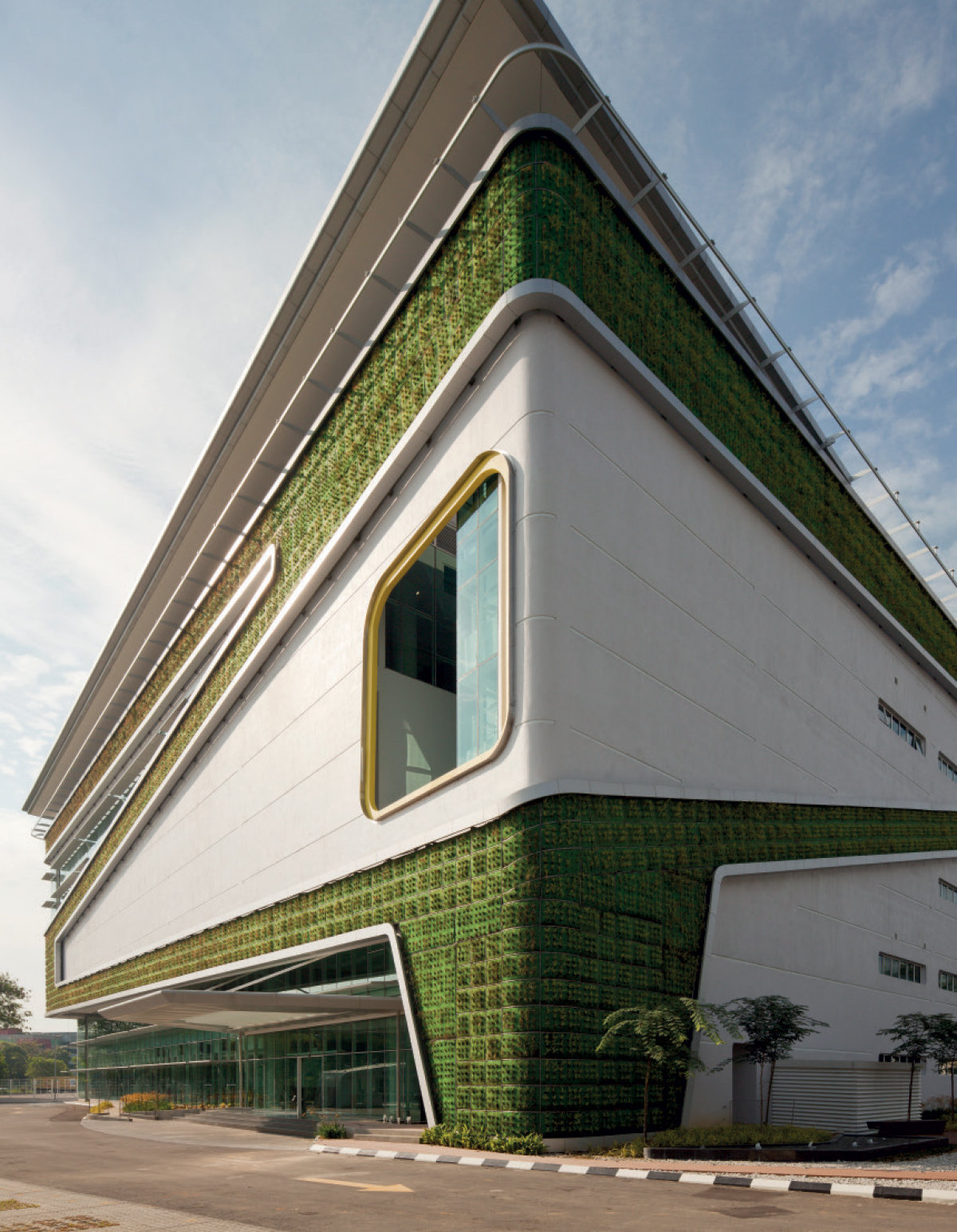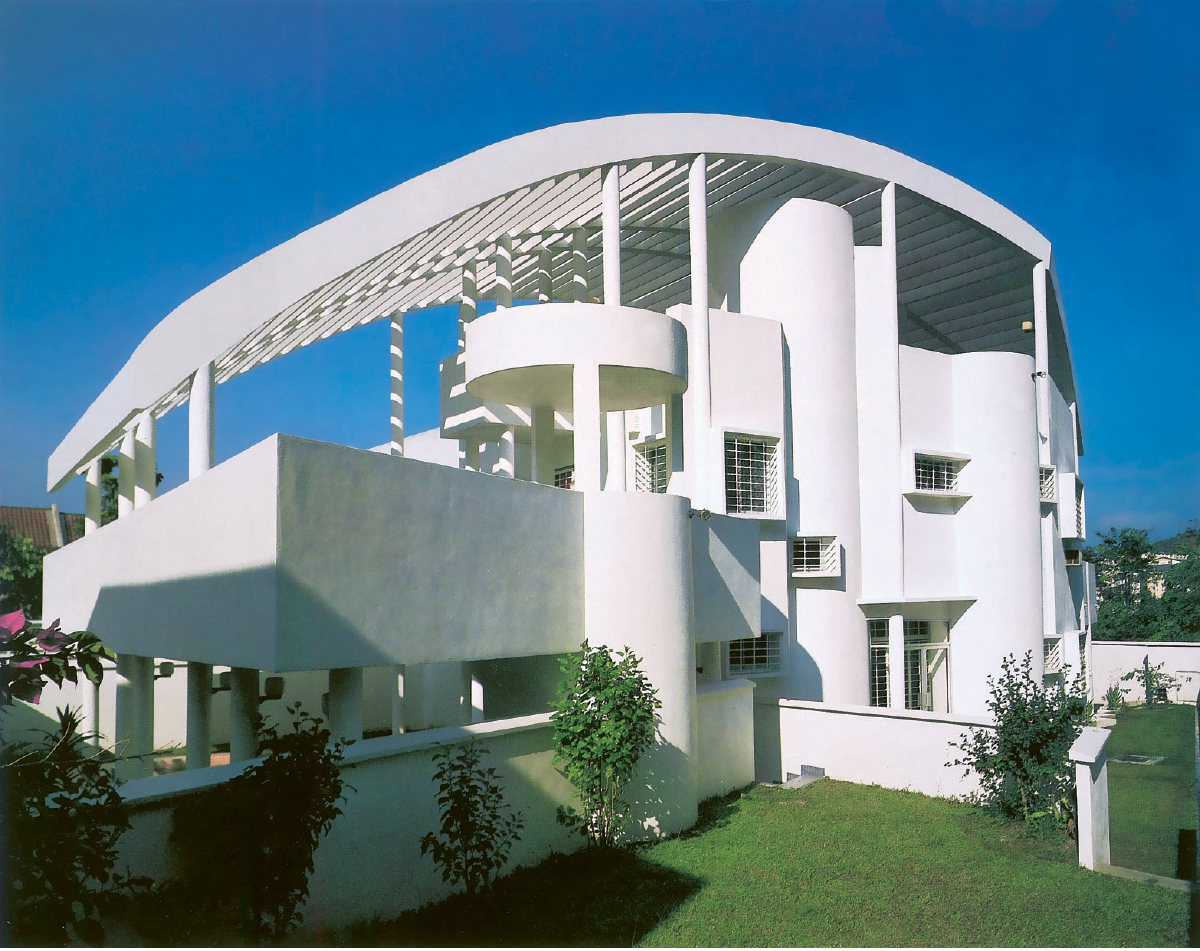
Right: Suasana Putrajaya’s double-glass facade doubles as a sun-shading device (Photo by TR Hamzah Yeang)
This article first appeared in City & Country, The Edge Malaysia Weekly on December 12, 2022 - December 18, 2022
Best known for his green architecture and master plans, architect and ecologist Datuk Ken Yeang has been working on green designs since the 1970s and authored more than 12 books on the subject.
Yeang is one of the principals and CEO of architecture firm TR Hamzah Yeang Sdn Bhd. The other is the firm’s chairman, Tengku Robert Hamzah. “[We] were students at the AA School [Architectural Association School of Architecture] in London, a school deemed the ‘hothouse for design’,” Yeang says via an email interview with City & Country.
“After graduation from AA, I started working in 1971 at Cambridge University as a research assistant on The Autarkic House project. This led to me doing a doctorate on the topic of ecological design, which afterwards became my life’s agenda from 1976,” he recounts.
Yeang’s current practice, which was established in 1976 and currently has four dozen staff, has projects in Malaysia as well as the UK, US, Hong Kong, India and China, with eight branch offices in China and one in the UK.
“Our company started with designing climate-responsive or bioclimatic buildings as passive-mode low-energy buildings in the 1990s as a subset of ecological architecture because it was difficult to get adequate consultant support at the time. Greener and better ecologically-engineered buildings were not possible until the late 1990s.
“Today, designing and working to save the planet is a task that all architects and developers — and, in effect, all of humanity — must address. Working to save the planet is no longer just one of the ways to mitigate negative impacts on the natural environment, but a crucial ‘race and rescue’ mission to repair and regenerate the natural environment,” says Yeang.
The firm’s ethos is “innovation, hyper-green, signature and people’s happiness-focused design”, which are its signature aesthetics and what make its work compelling, according to Yeang, who has been acknowledged by British newspaper The Guardian as among the “50 people who could save the planet” and was featured in an episode of US-based Public Broadcasting Service’s (PBS) e2 design series narrated by Academy Award winner Brad Pitt.
TR Hamzah Yeang has also garnered numerous accolades for its work, including the country’s Merdeka Award under the environment category, the PAM Gold Medal award from the Malaysian Institute of Architects (PAM), the Association of Siamese Architects’ Gold Medal and the Liang Sicheng Architecture Award from the Architectural Society of China.
Yeang, who joined the British Ecological Society in 1973, says that the firm’s work is unique as it is based on the science of ecology.
“Ecology is ultimately the ‘ground zero’ or originating environmental context within which all of human society’s technological systems, acts and endeavours on the planet take place,” he says.
“Our work now centres on ecomimicry or designing to emulate and replicate the attributes of ecosystems, whereas the work of most green architects in the industry is essentially ‘technocentric’, focusing mostly on the engineering aspects of green design such as net zero energy, net zero carbon and so on,” he says, adding that while the firm addresses the latter, it also gives “equally vital attention to design that integrates with the natural environment, such as the planet’s ecosystems, habitats and biogeochemical cycles”.
Examples of ecomimicry that he mentions are the use of renewable energy from the sun, the harvesting and purification of water, the internalised and local recycling of materials, and enhancing biological structure by greening.
“Most of our imitators put vegetation on their buildings essentially for decorative purposes, whereas in greening, we carefully select species that are non-invasive, contribute to enhancing local biodiversity and sequester aerial pollution through phytoremediation,” Yeang explains.
The other crucial focus in the firm’s work is innovation, which he defines as seeking to advance architecture, particularly in the field of green design.
Jewel in Putrajaya
Among the firm’s award-winning projects is Suasana Putrajaya, which boasts several innovative features and has a Green Building Index (GBI) Silver rating. Completed in 2017, Suasana Putrajaya was conceived as a premier cultural and commercial centre comprising offices and retail components in Putrajaya’s Precinct 2. Sited on a 3.8-acre parcel with a gross floor area of 813,316 sq ft, the development has a landscaping-to-site area ratio of 48% and a climate-responsive orientation based on the local sun path, according to the design brief.
As the building is designed to be a “jewel in Putrajaya”, it is presented as a crystalline-like structure with angled glass panels for its double-glass façade that wrap around the building and double as a sun-shading device. The outer layer, which has a white fritted songket pattern that covers up to 50% of each glass panel, acts as sunshade for the inner skin, while the cavity between the inner and outer layers is naturally ventilated and cuts down direct solar heat transfer.
Another feature at Suasana Putrajaya is its continuous green vegetation from the ground-level central promenade to the first-floor garden space. In addition, there are numerous balcony spaces, each with planter boxes. The design also allows continuous vegetation, daylight and natural ventilation to extend into the car-parking levels below.
Bioclimatic prototype
An old favourite of Yeang’s is the Roof-Roof House, which is also the architect’s own residence in Ampang, Selangor. Built in 1985, the 2-storey home with a roof terrace has a built-up area of 3,500 sq ft on a land area of 6,500 sq ft.
“Its style was influenced by [Swiss-French architect] Le Corbusier, its climate-responsive system was learnt from [Indian architect and urban planner] Charles Correa while its built-form aesthetics were influenced by [English architect] Peter Cook,” he highlights.
The house is designed as a life-size working prototype of the architect’s bioclimatic design ideas. Conceptually, the building works as a “valve” or an enclosure system that operates as an environmental filter, using climatic factors to opportunistically shape the building’s enclosure, configuration and spatial organisation, according to the design brief.
For example, its north-south orientation protects the major spaces from the tropical sun, and the ground-floor living spaces, which open out to the poolside, are oriented to take advantage of the wind direction. The breeze will be cooled by the pool before entering through the moveable layers of the design, namely the sliding grilles, glass panels, solid panels and adjustable blinds, which make up the working components of the “valve” analogy and allow levels of environmental articulation by the users for privacy, ventilation, natural lighting, space usage, security and comfort.
The house design also has a baffle roof that sweeps over not only the actual flat roof of the first floor, but also over the pool terrace below. The sectional design of the roof is angled or shaped over the building to reduce insolation over the west and noonday sun while letting in the morning rays.
By comparison to other vernacular architecture approaches that respond to the local climate, the Roof-Roof House differs in that it is intentionally designed not as a passive structure but to function as a system of working parts. The prototype can also be extended to larger-scale urban high-rises.
Living art
Another project Yeang highlights is the Digi Technology Operation Centre (now known as CelcomDigi Technology Operation Centre) in Subang Hi-tech Industrial Park, Shah Alam. It was completed in 2010 and has a GBI Gold rating. The building is designed to optimise the data centre footprint, provide effective drainage and waterproofing to protect sensitive equipment, reduce solar heat gain into the data centre and allow for effective security measures. Its extensive vertical green walls act as living, breathing and regenerative cladding, not to mention living art installation and biological air filter. The indoor and outdoor green walls help decrease local CO2, regulate humidity levels, trap dust, reduce noise and create a habitat for urban wildlife.
The exterior green wall installations reduce solar gain or the entrapment of heat by passive solar gain on the building surface and, by extension, building energy costs; provide protection from the effects of UV radiation and acid rain; and help reduce the building’s contribution to the heat island effect.
Kaizen
Currently, the firm is working on a “super low-energy, hyper-green data centre”, which Yeang says is “a crucial building type in today’s rapidly digitalising world”.
“Our best projects are always our latest where each new one builds on the lessons we learnt from previous projects in a process of constant improvement, which is referred to by the Japanese as ‘kaizen’.”
Save by subscribing to us for your print and/or digital copy.
P/S: The Edge is also available on Apple's App Store and Android's Google Play.
- Fire incident in Putra Heights not related to Gas Malaysia facilities, company says
- Petronas confirms fire incident at Petronas Gas main pipeline near Puchong
- Massive gas pipeline fire in Puchong — Fire Dept
- Gas pipeline blaze: 25 receiving initial medical treatment as of 10.35am
- Singapore’s Capital World says MACC froze its unit CCP’s bank accounts to facilitate ongoing investigations
- Gas pipeline blaze: 190 houses, 159 vehicles damaged
- SoftBank seeks record US$16.5b loan for AI growth in US — Bloomberg
- RHB Singapore appoints Goh Ken-Yi as CEO
- Gas pipeline blaze: Immediate financial aid for over 100 affected residents, says PM
- Gas pipeline blaze: PLUS reopens Seafield to Bandar Saujana Putra route




